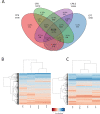The sino-nasal warzone: transcriptomic and genomic studies on sino-nasal aspergillosis in dogs
- PMID: 33184275
- PMCID: PMC7665010
- DOI: 10.1038/s41522-020-00163-7
The sino-nasal warzone: transcriptomic and genomic studies on sino-nasal aspergillosis in dogs
Abstract
We previously showed that each dog with chronic non-invasive sino-nasal aspergillosis (SNA) was infected with a single genotype of Aspergillus fumigatus. Here, we studied the transcriptome of this fungal pathogen and the canine host within the biofilm resulting from the infection. We describe here transcriptomes resulting from natural infections in animal species with A. fumigatus. The host transcriptome showed high expression of IL-8 and alarmins, uncontrolled inflammatory reaction and dysregulation of the Th17 response. The fungal transcriptome showed in particular expression of genes involved in secondary metabolites and nutrient acquisition. Single-nucleotide polymorphism analysis of fungal isolates from the biofilms showed large genetic variability and changes related with adaptation to host environmental factors. This was accompanied with large phenotypic variability in in vitro stress assays, even between isolates from the same canine patient. Our analysis provides insights in genetic and phenotypic variability of Aspergillus fumigatus in biofilms of naturally infected dogs reflecting in-host adaptation. Absence of a Th17 response and dampening of the Th1 response contributes to the formation of a chronic sino-nasal warzone.
Conflict of interest statement
The authors declare no competing interests.
Figures









Similar articles
-
What causes canine sino-nasal aspergillosis? A molecular approach to species identification.Vet J. 2014 Apr;200(1):17-21. doi: 10.1016/j.tvjl.2014.01.009. Epub 2014 Jan 23. Vet J. 2014. PMID: 24559745
-
Comparative genotyping and phenotyping of Aspergillus fumigatus isolates from humans, dogs and the environment.BMC Microbiol. 2018 Sep 17;18(1):118. doi: 10.1186/s12866-018-1244-2. BMC Microbiol. 2018. PMID: 30223790 Free PMC article.
-
Analysis of gene expression in canine sino-nasal aspergillosis and idiopathic lymphoplasmacytic rhinitis: a transcriptomic analysis.Vet Microbiol. 2012 May 25;157(1-2):143-51. doi: 10.1016/j.vetmic.2011.12.009. Epub 2011 Dec 14. Vet Microbiol. 2012. PMID: 22221380
-
Canine sino-nasal aspergillosis: parallels with human disease.Med Mycol. 2009;47 Suppl 1:S315-23. doi: 10.1080/13693780802056038. Epub 2008 Jun 23. Med Mycol. 2009. PMID: 18608893 Review.
-
Genes and molecules involved in Aspergillus fumigatus virulence.Rev Iberoam Micol. 2005 Mar;22(1):1-23. doi: 10.1016/s1130-1406(05)70001-2. Rev Iberoam Micol. 2005. PMID: 15813678 Review.
Cited by
-
Variation of virulence of five Aspergillus fumigatus isolates in four different infection models.PLoS One. 2021 Jul 9;16(7):e0252948. doi: 10.1371/journal.pone.0252948. eCollection 2021. PLoS One. 2021. PMID: 34242260 Free PMC article.
-
Assessment of the nasal microbiota in dogs with fungal rhinitis before and after cure and in dogs with chronic idiopathic rhinitis.BMC Microbiol. 2023 Apr 15;23(1):104. doi: 10.1186/s12866-023-02828-7. BMC Microbiol. 2023. PMID: 37061685 Free PMC article.
-
Growth of Aspergillus fumigatus in Biofilms in Comparison to Candida albicans.J Fungi (Basel). 2022 Jan 4;8(1):48. doi: 10.3390/jof8010048. J Fungi (Basel). 2022. PMID: 35049988 Free PMC article. Review.
-
A Case of Canine Sinonasal Aspergillus fumigatus Infection Associated With Intracranial Extension and Temporal Myositis.Vet Med Sci. 2025 Jan;11(1):e70188. doi: 10.1002/vms3.70188. Vet Med Sci. 2025. PMID: 39740066 Free PMC article.
References
MeSH terms
Substances
LinkOut - more resources
Full Text Sources
Medical
Research Materials

